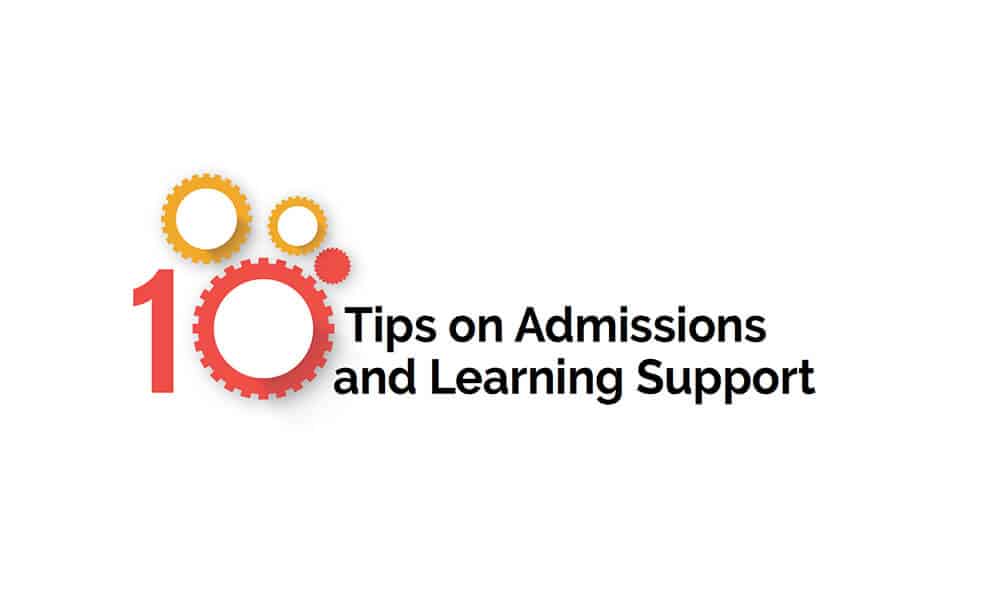Your school may have very limited resources for meeting the needs of students for whom learning support is required, or perhaps you work at a fully inclusive school with a broad array of learning support programs… Or maybe you are somewhere in between, still considering in which direction to go. The fact of the matter is that no matter where your school lies on the learning support spectrum, all international school admissions departments have to manage the expectations of families of students with learning support needs.
As a leading international school in terms of inclusion, about twenty percent of inquiries to The International School of Brussels are from families with children with learning support needs. While the school prides itself on its inclusive programs, there are limits to its ability to meet the needs of such students, leading to the difficult tasks of running waiting lists or denying applicants. Over the past few years, the Admissions Department at ISB has learnt a number of lessons about admissions and learning support that we would like to share with you here.
1 The more inclusive your school is, the more challenging your job is
- In less inclusive schools, admissions officers can more easily play the role of “gatekeeper” and simply turn away applicants with learning support needs by saying “We don’t have the resources to meet your child’s needs”.
- In schools with significant support programs, applications have to be looked at closely to determine if needs can be met. If they can be, then you have to be able to explain programs and any special conditions. If you deny an application, then the family usually wants to know why, and they often expect recommendations for alternate options.
3 Speak with a common voice
- Your overall school community, from individual stakeholders to messages on the website, should be aligned with the school’s mission and values in relation to learning support.
- During the admissions process, the Admissions Office should take the lead in communicating with families. All stakeholders involved in the process (admissions officers, division leaders, learning support department, counselors, and even the finance department) must be on the same page when communicating with families. Important emails should be copied to key stakeholders involved and records of vital phone calls and interviews should be shared.
5 Collaborate with learning support staff regularly
- Invite learning support staff (ideally the Head of Learning Support) to attend interviews with prospective families. They are better qualified than admissions office staff to both explain programs and discuss students’ needs for support.
- Have regular meetings with Learning Support staff to go over numbers and individual students at different stages of the admissions funnel.
7 Consider the delicate balance between marketing the school and managing expectations
- While it is important to detect needs early, be careful not to scare families away. You do not want prospective parents’ first impression of you to be like that of a “hospital triage room” with a checklist of direct questions from the start about possible learning difficulties. At the same time, you must not avoid the difficult questions, as they may come back to haunt you later if you do not ask them. Look for that delicate balance between obtaining crucial information and presenting the school in a professional and friendly, welcoming way.
9 Deliver decisions in a timely, professional manner
- We all know that denials and waiting list decisions are the most difficult to communicate to families. Make sure the person who has made the decision (Division Head, Head of Learning Support, School Director, etc.) has clearly explained the reasons to you. That knowledge will enable you to communicate with the family more confidently and competently – whether or not you share all of the information you have.
- Communicate denials and waiting list decisions both for the record in writing and, when possible, orally over the phone or in person. First, however, anticipate how the family may react, then prepare yourself for that reaction. If you think they might try to go beyond you, to a person higher up in the school such as the Director, to plead their case, consider giving that person a heads up with some background information in advance.
2 Know learning support at your school inside out
- Find out where your school stands on learning support in terms of its mission and values.
- Get to know the programs on offer, visit classes, meet students and teachers and listen to their stories.
4 Detect needs early
- The sooner you find out if you can meet the needs of a prospective learning support student (in terms of programs, resources, and space availability), the sooner you can confidently inform the family of whether or not to pursue an application.
- In cases where you cannot meet the needs of the family, detecting needs early will save you a lot of trouble later, while in cases where you can, it will allow you and the family more time to get to know each other well and establish a positive relationship that will continue after enrollment.
6 Strive to get real-time data on numbers
- In order to manage prospective parents’ expectations, it is important to know how many spaces you have available, but be careful since numbers can go up or down due to internal factors such as current students being designated as requiring (or no longer requiring) learning support.
- Although you may have a percentile quota for students requiring learning support, also be careful about absolute numbers (as opposed to percentages) since increases in absolute numbers that do not alter increases in terms of percentage may still have an impact on staffing and budgeting.
- You may have to collaborate with your IT department to develop an efficient way of monitoring numbers in real time.
8 Confront non-disclosure – but don’t make assumptions about it
- Even though you may ask families directly on the phone, via email, on inquiry forms, in interviews, and on application forms, if their children have diagnosed learning support needs, some will downplay or even deny that their children have such needs when they actually do have them. A natural first assumption would be to think that the family is lying so that you will accept their child. Although this occurs from time to time, it may also be due to linguistic or cultural misunderstandings about the meaning of learning support.
- Misunderstandings can occur with families coming from English speaking countries too. Many families think that their “gifted and talented” (highly able) children have no need for support but due to their uneven profiles (very strong in some areas, very weak in others) they often need support, for example, for executive functions. US families with children who have a “504 Plan” might deny that they need support, since 504 Plans can be based on medical and not pedagogical conditions. See the pop quiz on page 31 for more on executive functions and 504 plans.
- Direct questions work with some families, but a more indirect approach might work better with others. Let the family tell you their story and some red flags just might appear.
10 Know the local community
- Knowing the local community will allow you to connect more confidently with local families and educators.
- Your school will be in a better position to tap into local learning support resources in such cases where they can be beneficial.
- A good understanding of local attitudes, language and terminology, resources, programs and educational options will also allow you to propose alternatives to families – both local and international – that you cannot accept.
What is an Inclusive School?
“Inclusive schools successfully serve a managed number of students representing the full range of learning differences: mild, moderate, intensive and those of the exceptionally able.”
Next Frontier Inclusion (NFI)
















 All Services
All Services


